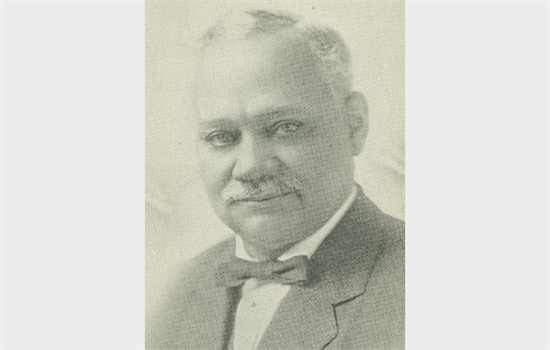Post office OK'd to hang portrait of Elaine accused’s defender
Washington,
December 14, 2020
Post office OK'd to hang portrait of Elaine accused’s defender
Arkansas Democrat-Gazette 12/14/20
WASHINGTON -- President Donald Trump has signed legislation allowing Little Rock's Scipio A. Jones post office to "accept and display" a portrait of its namesake. John Gill, a Little Rock attorney who pushed for the painting, hopes to raise $50,000 to pay for it. "It's going to be something that'll take some time and take some effort, and we are just getting started. Hopefully, we can get it done," he said. The law specifies that artist Wade Hampton, an Arkansas native, will create the portrait. Placing portraits in post offices isn't easy, Gill said he has learned. "We had to get an act of Congress to get this done," he said. U.S. Rep. French Hill, R-Ark., who introduced the legislation, said Jones has claimed a place "in Arkansas and American history as one of the most exceptional lawyers of his time." Yet his story is not widely known. The painting will acknowledge Jones as a role model "for Arkansans, generally, and those seeking a career in the law, specifically," Hill said. "This will be a real enhancement to the Jones post office on Main Street, and instrumental in telling a new generation of younger Arkansans about Scipio Jones," the lawmaker from Little Rock said. Born a slave in Dallas County in 1863, Jones moved in the 1880s to the Little Rock area where he studied at the institutions that are now known as Philander Smith College and Shorter College. After legal apprenticeships, Jones was admitted to the practice of law in Pulaski County in 1889. Admission to the U.S. Supreme Court bar followed in 1905. During his half-century-long career, Jones repeatedly challenged injustices in the post-Reconstruction South. Over the years, he developed a national reputation. "He was one of the most well-known African-American attorneys in the country, so he was a huge deal in his lifetime," said Brian Mitchell, a history professor at the University of Arkansas at Little Rock. After the 1919 Elaine Massacre, Jones defended 12 Black men who had been rounded up, charged with murder and summarily condemned by all-white juries. The wave of violence was labeled an insurrection or a "race riot," at the time. Modern historians say whites spilled most of the blood. The trouble began outside a church where a group of Black farmers had gathered for a union meeting. By organizing, the tenant farmers and sharecroppers had hoped to obtain better terms from white land owners. Armed whites approached the building, which was protected by Black armed guards. Gunfire erupted. In the hours and days that followed, as many as 300 Blacks lost their lives, the National Association for the Advancement of Colored People would later claim. Once the physical violence ended, the legal lynchings began, critics say. When law enforcement intervened, it was Blacks who were rounded up and rushed to trial. In "a Southern community inflamed by racial hysteria," it was hard for a Black man to obtain a fair trial, Felix Frankfurter wrote in 1932, shortly before becoming a Supreme Court justice. In order for local authorities to obtain incriminating testimony, Black witnesses had been whipped with metal-studded strips and otherwise tortured until they complied, affidavits alleged. The proceedings had been perfunctory. Armed whites converged at the courthouse, demanding that the accused be condemned. Counsel for the defense called no witnesses, the accused did not testify on their own behalf, and guilty verdicts were delivered in less than five minutes, it was alleged. Death sentences quickly followed. After glimpsing Phillips County justice up close, dozens of other defendants simply pleaded guilty and were handed lengthy prison sentences. Eventually, Jones stepped in. With his clients facing execution or lengthy prison sentences, he fought their convictions, in both state and federal courts, joining forces with the NAACP along the way. Together, they would pursue, in the words of NAACP Executive Director Roy Wilkins, a "desperate four-year search for justice." State officials argued that the U.S. Supreme Court lacked jurisdiction over the case and should not second-guess the jurors. There was little sympathy for the defendants in Arkansas, Wilkins noted. "On the other side were ranged all the officeholders of the state, including the governor and the attorney general, all the newspapers and 99.5 percent of the general white public," he later wrote. Eventually, an appeal was filed with the U.S. Supreme Court, arguing that the accused had been deprived of their constitutional rights. After reviewing the case, Moore v. Dempsey, the high court agreed. "According to the allegations and affidavits there never was a chance for the petitioners to be acquitted; no juryman could have voted for an acquittal and continued to live in Phillips County and if any prisoner by any chance had been acquitted by a jury he could not have escaped the mob," the majority stated in the justices' 6-2 decision. When defendants are denied due process of law and state courts fail to fix the problem, then the federal courts would intervene, the 1923 landmark ruling showed. Looking back at the case a decade later, Felix Frankfurter boiled the case down to its essence. "Certain things are basic to the integrity of the judicial system," he wrote. "One of them is a proper tribunal, impartial and uncoerced." Moore v. Dempsey was a giant step forward, Gill said. Jones helped make it happen, against all odds. "He went into the courts with, really, the deck stacked against him," Gill said. "In the end, he provided justice for his clients." |



